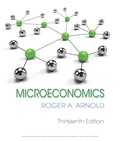
Determine the market structure that is common in all the four firms.
Explanation of Solution
The common criterion in all the four firms’ market structure based on the pricing decision is that all the firms produce the quantity of output where the marginal cost is equal to marginal revenue.
Oligopoly: Oligopoly is the type of market structure, which is considered by few sellers who exist in the market with a large market share, high barriers to entry, and selling differentiated products.
Want to see more full solutions like this?
- Explain reasons for why some people believe having just a few firms in an industry is desirable?arrow_forwardwhy do many economists, pundits, and government officials continue to believe that the state must possess the power to regulate, or even to break up, firms simply because some particular firms are today large or “dominant”?arrow_forwardDiscuss the four basic market structures with the aid of graphsarrow_forward
- How do bargaining and command relations affect the size of profits created in a capitalist firm?arrow_forwardWhat do you think is the most ideal and beneficial type of Market Structure? Why?arrow_forwardWhat are the three major legal forms of business organization? Which form is the most prevalent in terms of numbers? Why do you think that is so? Which form is dominant in terms of total sales? What major advantages of this form of business organization gave rise to its dominance?arrow_forward
- Who was one who developed duopoly model in the economics??arrow_forwardLet's assume that the table below represents the market shares for the smart phone market. Firm Market Share Apple 44% Fujitsu 3% Kyocera 2% LG 3% Motorola 13% Samsung 24% Sanyo 4% Siemens 2% Sony Ericsson 5% Based on this information, the four-firm concentration ratio isarrow_forwardV11 Read the article Internationally Acclaimed Quilter Claims Fraud in Lawsuit Seeking Share of Quilts’ Profits. According to the article, “[t]he lawsuit says any agreement between the quilters and the defendants was oral and was not put into writing.” After studying the statute of frauds in this unit, why is the failure to put the agreement into writing problematic? Be specific in your answer, citing any of the statutes of frauds that you think may apply to the lawsuit. "New Answerarrow_forward
- What are the dominant types of firms that exist in Dubai? Provide two (2) examples per type identified?arrow_forwardProvide a short intuitive explanation for the differences between the Nash equilibrium prices and those that maximize joint profit. Why is joint profit maximization not a Nash equilibrium?arrow_forwardStudent question Time Left : 01:59:43 Ch. 4. Agglomeration Economies and Equilibrium vs. Efficient Cluster Size. The graph shows the relationship between the number of firms in a cluster (on the x-axis), against the profit per firm (on the y-axis). The curve shows the profit per firm as cluster size varies. Point A shows a single isolated firm, which earns a profit of 7₁ T2 T3 π1 1 b Profit per firm Profit: isolated firm 6 Number of firms in a cluster 14 a. Identify the point on the curve that represents the Pareto efficient outcome. What is the Pareto efficient number of firms and profit per firm? b. Identify the point on the curve that represents the Nash equilibrium outcome. What is the equilibrium number of firms and the equilibrium profit per firm? c. In one to two sentences, explain why your answers to parts a & b are different (or why they are the same, if that's the case). For the toolbar, press ALT+F10 (PC) or ALT+FN+F10 (Mac).arrow_forward
 Economics (MindTap Course List)EconomicsISBN:9781337617383Author:Roger A. ArnoldPublisher:Cengage Learning
Economics (MindTap Course List)EconomicsISBN:9781337617383Author:Roger A. ArnoldPublisher:Cengage Learning
 Economics Today and Tomorrow, Student EditionEconomicsISBN:9780078747663Author:McGraw-HillPublisher:Glencoe/McGraw-Hill School Pub Co
Economics Today and Tomorrow, Student EditionEconomicsISBN:9780078747663Author:McGraw-HillPublisher:Glencoe/McGraw-Hill School Pub Co Exploring EconomicsEconomicsISBN:9781544336329Author:Robert L. SextonPublisher:SAGE Publications, Inc
Exploring EconomicsEconomicsISBN:9781544336329Author:Robert L. SextonPublisher:SAGE Publications, Inc Managerial Economics: A Problem Solving ApproachEconomicsISBN:9781337106665Author:Luke M. Froeb, Brian T. McCann, Michael R. Ward, Mike ShorPublisher:Cengage Learning
Managerial Economics: A Problem Solving ApproachEconomicsISBN:9781337106665Author:Luke M. Froeb, Brian T. McCann, Michael R. Ward, Mike ShorPublisher:Cengage Learning Microeconomics: Principles & PolicyEconomicsISBN:9781337794992Author:William J. Baumol, Alan S. Blinder, John L. SolowPublisher:Cengage Learning
Microeconomics: Principles & PolicyEconomicsISBN:9781337794992Author:William J. Baumol, Alan S. Blinder, John L. SolowPublisher:Cengage Learning





